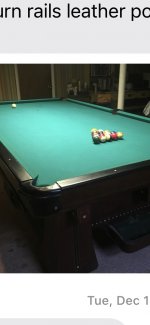I have recently purchased a 1913 - 1916 Brunswick Kling. It is a 6 leg, Circassian Walnut / Rosewood Rail, 1.5” slate with ball return. I have begun restoration but am not a pro, but very handy and capable. My parents were antique dealers so I understand restoration and not to overdo it and leave some “patina“. i have included some puctures. One thing i am particularly interested in is the serial numbering etc. It is numbered 5840 everywhere and 40 written on many parts. Is there any way to chase these numbers down to understand what they may lead to? i have begun stripping it and sanding and. Trying to figure our stains, if any, types of clearcoats, etc. generally anything to keep it authentic. Looking for comments from folks who know.
You are using an out of date browser. It may not display this or other websites correctly.
You should upgrade or use an alternative browser.
You should upgrade or use an alternative browser.
1916 Brunswick Kling Restoration
- Thread starter OC Skip
- Start date
I’ve had a four-legged kling for 40+ years. The legs and cabinet are veneer, so I don’t believe you would sand those down unless it’s so old that all the veneer has already been stripped off, which doesn’t appear to be the case from your photo.I have recently purchased a 1913 - 1916 Brunswick Kling. It is a 6 leg, Circassian Walnut / Rosewood Rail, 1.5” slate with ball return. I have begun restoration but am not a pro, but very handy and capable. My parents were antique dealers so I understand restoration and not to overdo it and leave some “patina“. i have included some puctures. One thing i am particularly interested in is the serial numbering etc. It is numbered 5840 everywhere and 40 written on many parts. Is there any way to chase these numbers down to understand what they may lead to? i have begun stripping it and sanding and. Trying to figure our stains, if any, types of clearcoats, etc. generally anything to keep it authentic. Looking for comments from folks who know.
Very nice project indeed! I have always preferred a more muted finish on antique wood furniture restorations. For me, something like Tung oil worked very well- anything that is penetrating to some extent, and definitely not heavy in the shine or gloss category. Very fine, final finish sanding techniques help to reveal the degree of shine in your ultimate finish that you desire for this table. The words "clear coat" on packaging can mean a lot of variation in the gloss of a finish - I like the oil finishes.
Is it a 10 footer? If it is the only rubber available is billiards rubber and it will go 6 rails with worn simonis 860 and not full power....Full power will cause ball to jump off table.I have recently purchased a 1913 - 1916 Brunswick Kling. It is a 6 leg, Circassian Walnut / Rosewood Rail, 1.5” slate with ball return. I have begun restoration but am not a pro, but very handy and capable. My parents were antique dealers so I understand restoration and not to overdo it and leave some “patina“. i have included some puctures. One thing i am particularly interested in is the serial numbering etc. It is numbered 5840 everywhere and 40 written on many parts. Is there any way to chase these numbers down to understand what they may lead to? i have begun stripping it and sanding and. Trying to figure our stains, if any, types of clearcoats, etc. generally anything to keep it authentic. Looking for comments from folks who know.
Yes it is a 10’. Please explain the full power comment to this newbie. ThxIs it a 10 footer? If it is the only rubber available is billiards rubber and it will go 6 rails with worn simonis 860 and not full power....Full power will cause ball to jump off table.
On normal rubber you (or me) can normally shoot full power from the head spot towards the end rail and the ball will come back about 4.5 table lengths on a normal table. With the only rubber (billiard) available on a 10' you will get about 6 table lengths without full power (which on a 9 footer would be over 6.5 table lengths...which is insanely fast for 860). If you were to use full power you risk the ball flying back in your face. The fact that the table I've tried this on that does this might be that the rails weren't converted from monarch rubber to k-55 rubber properly though.....and if they were converted properly maybe 7+ table lengths would be possible.Yes it is a 10’. Please explain the full power comment to this newbie. Thx
On a table this fast you want to use multi rail position every chance you get because with 1 rail position (and especially for longer distances) you are always in jeopardy of overrunning your mark. It does make forcing the ball around the table off the rails when you get somewhat straight a lot easier though....
Last edited:
